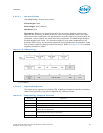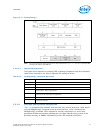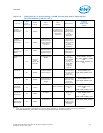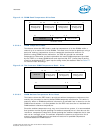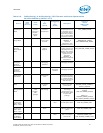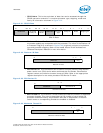
Intel® Xeon® Processor E5-1600 v2/E5-2600 v2 Product Families 43
Datasheet Volume One of Two
Interfaces
2.5.2.6.8 DRAM Power Info Read
This read returns the minimum, typical and maximum DRAM power settings and the
maximum time window over which the power can be sustained for the entire DRAM
domain and is inclusive of all the DIMMs within all the memory channels. Any power
values specified by the power limiting entity that is outside of the range specified
through these settings cannot be guaranteed. Since this data is 64 bits wide, PECI
facilitates access to this register by allowing two requests to read the lower 32 bits and
upper 32 bits separately as shown in Table 2-6. Power and time units for this read are
defined as per the Package Power SKU Unit settings described in Section 2.5.2.6.11.
The minimum DRAM power in Figure 2-18 corresponds to a minimum bandwidth
setting of the memory interface. It does ‘not’ correspond to a processor IDLE or
memory self-refresh state. The ‘time window’ in Figure 2-18 is representative of the
rate at which the power control unit (PCU) samples the DRAM energy consumption
information and reactively takes the necessary measures to meet the imposed power
limits. Programming too small a time window may not give the PCU enough time to
sample energy information and enforce the limit while too large a time window runs the
risk of the PCU not being able to monitor and take timely action on energy excursions.
While the DRAM power setting in Figure 2-18 provides a maximum value for the ‘time
window’ (typically a few seconds), the minimum value may be assumed to be
~100 mS.
The PCU programs the DRAM power settings described in Figure 2-18 when DRAM
characterization has been completed by the memory reference code (MRC) during boot
as indicated by the setting of the RST_CPL bit of the BIOS_RESET_CPL register. The
DRAM power settings will be programmed during boot independent of the ‘DRAM Power
Limit Enable’ bit setting. Please refer to the Intel® Xeon® Processor E5 v2 Product
Family Processor Datasheet, Volume Two: Registers for information on memory energy
estimation methods and energy tuning options used by BIOS and other utilities for
determining the range specified in the DRAM power settings. In general, any tuning of
the power settings is done by polling the voltage regulators supplying the DIMMs.
Figure 2-17. Accumulated DRAM Energy Data
0
Accumulated DRAM Energy Data
Accumulated DRAM Energy
31
15
2
Parameter format
Reserved Channel Index
3 0



